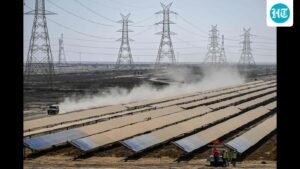
Ten years ago, India flipped the script on its approach to climate negotiations. It worked with rich and poor countries to craft the Paris Agreement, launch the International Solar Alliance, supported Mission Innovation, set out ambitious targets for energy access and clean energy, and positioned itself as a champion of climate justice. A decade thereon, the dynamism of India’s economy is more evident, as is the scale of its energy transition. But it now faces a fork in the road: Will it build on this legacy or allow global climate reversals to insert road bumps on its path to sustainable growth?

At COP30 — starting in Belém, Brazil today — there will be much hand-wringing about what’s not happening and who is to blame. Cutting through the noise and the jargon of negotiation texts, there are primarily two gaps that must be filled. One is the ambition gap, or how much more we must collectively act to keep the temperature increase within relatively safe limits. The other is the implementation gap, or how we fulfill the promises made on actions at home and to support others. There is, however, a third gap too — a perception gap, or a misreading of what developing countries are already doing to combat the climate crisis. India must approach COP30 with a strategy to bridge all three gaps. It must own its story (what it has achieved) and also write a new story, a new narrative, which reflects a bold commitment to climate action.
The ambition gap is real. Carbon dioxide (CO2) emissions increased 1.2% annually in the decade following the Paris Agreement, compared to 18.4% over the 10 years that preceded this decade. This shifted the trajectory from 3-3.5°C of projected warming to 2.3-2.5°C (if all Nationally Determined Contributions are implemented), according to the latest UNEP Emissions Gap Report. But this is not enough, and the US leaving the Paris Agreement has canceled 0.1°C of temperature reduction. Much more must be done. The climate crisis is a lived reality for us.
The Asia-Pacific region has witnessed the largest number of extreme events since 1970 and the highest loss of lives (over 980,000) globally. Disasters have caused more than $4.3 trillion of economic losses globally between 1970 and 2021. Yet, in the least developed countries and small island developing States, 84% of events lack data on disaster-related economic damages, masking the true scale of vulnerability.
The ambition gap would not be as stark if the implementation gap were narrower. But countries are failing to keep their promises. Recent CEEW research found that only two developed countries were on track to meet their 2030 NDCs. The promise of $100 billion of climate finance was finally met in 2022, but much of it is in the form of loans, not grants. Another recent CEEW study found that less than a third of more than 200 climate cooperation initiatives launched since 2015 focused exclusively on the Global South.
But it is the perception gap that cuts the deepest. There are misplaced, misdirected, and misinformed perceptions that developing countries are not doing their bit. Even in absolute terms, let alone adjusted for their levels of development or per capita emissions, many developing countries and emerging markets are demonstrating climate action faster and further than advanced economies. In countries such as Brazil, Nepal, and Kenya, the share of clean electricity or renewables in total electricity generation is already higher than in many rich ones. India has already met its 2030 goal of 50% of power generation capacity from non-fossil sources five years ahead of schedule (in July 2025). Our calculations suggest that it will also surpass its emission intensity reduction target of 43-45% (against 2005 levels) and instead achieve a 48-57% reduction by 2030.
India’s story extends well beyond NDC overachievements. It has the world’s largest green hydrogen mission — with a central allocation of $2.5 billion and existing state-level policies having the potential to unlock another $61 billion. Its critical minerals mission strongly emphasizes mineral recycling, thereby reducing the resource footprint of energy transition. It is the first country to have developed a taxonomy on green steel. The Indian Carbon Market will be launched in its initial avatar by 2026. Put together, the range of clean energy, energy efficiency and sustainable transport policies (if they meet their targets) would result in almost 4 billion tonnes of CO2 reduction between 2020 and 2030. India has never committed to emissions reduction, and yet its domestic policies will deliver such a substantial result this decade alone.
India’s actions stretch beyond its borders. The International Solar Alliance has more than 100 fully signed-up members. The Coalition for Disaster Resilient Infrastructure has 51 member countries and 10 partner organizations.
At COP30, a decade of implementation of the Paris Agreement will be launched. India must reiterate and fight for the principle of climate justice, but it must also articulate a new narrative of agency – of action at speed and scale. Such a narrative must offer solutions in at least five areas.
Convert climate finance into investment: Developing countries are tired of promises of climate finance. This finance must derisk much greater volumes of investment at the country and programmatic levels. Meanwhile, new platforms like India’s GIFT City are showing how lowering transaction costs and improving regulatory clarity can connect global green capital with credible projects in the Global South. Adaptation and nature-based investments should value the communities safeguarding these ecosystems.
Build moral and monetary solidarity for loss and damage: Loss and damage funding is not aid; it is a matter of justice and shared responsibility. A modest contribution — just 0.08% of the GDP of the most-responsible countries — could mobilize $60 billion a year, far exceeding the $800 million pledged so far. A robust moral and economic framework can make this solidarity fair and transformative for the most vulnerable.
Move from technology transfer to technology co-development: Developing countries must be partners — not just markets — in the next wave of clean technologies. Co-developed clean-tech supply chains can reduce costs, diversify manufacturing, and accelerate deployment. India’s Digital Public Infrastructure (DPI) — open, safe, and inclusive by design — can serve as a platform to make AI-driven and data-enabled climate solutions transparent, interoperable, and accessible to all.
Build a broader green economy: The green transition must go beyond renewable energy. Integrating the circular and bio-economy makes climate action more consistent with the development realities of the Global South. These sectors have far higher employment coefficients and can attract trillions in new investment by creating entirely new value chains, from waste-to-wealth to green materials and bio-based manufacturing.
Finally, shape markets for sustainable lifestyles: Behavioral change must meet market opportunity. Governments and businesses must co-create markets that respond to new consumption patterns — from clean mobility to reduced material use to climate-friendly and nutritious food choices — making sustainability both aspirational and affordable. India’s Mission LiFE (Lifestyle for Environment) is a start and should be leveraged further.
If India seeks to be the voice of the Global South, it must shed its hesitations. Its actions speak louder than words, and its lessons should be shared.
Arunabha Ghosh is the CEO of Council on Energy, Environment and Water, and Special Envoy to COP30 representing South Asia. The views expressed are personal





